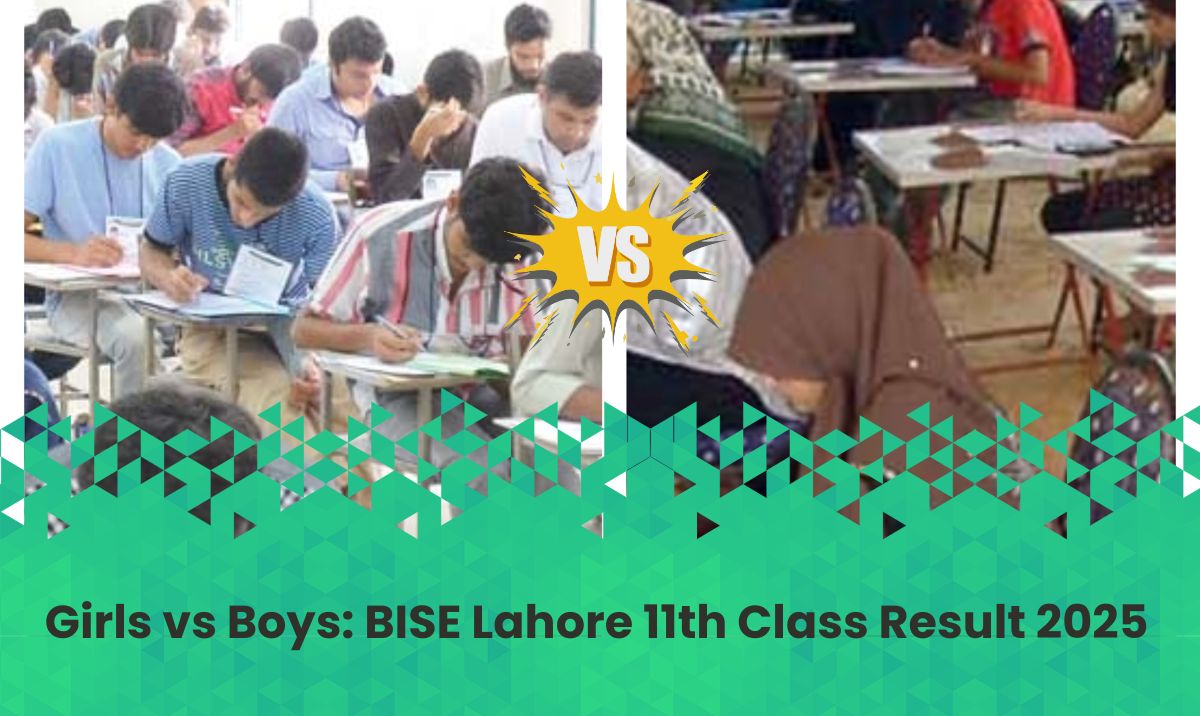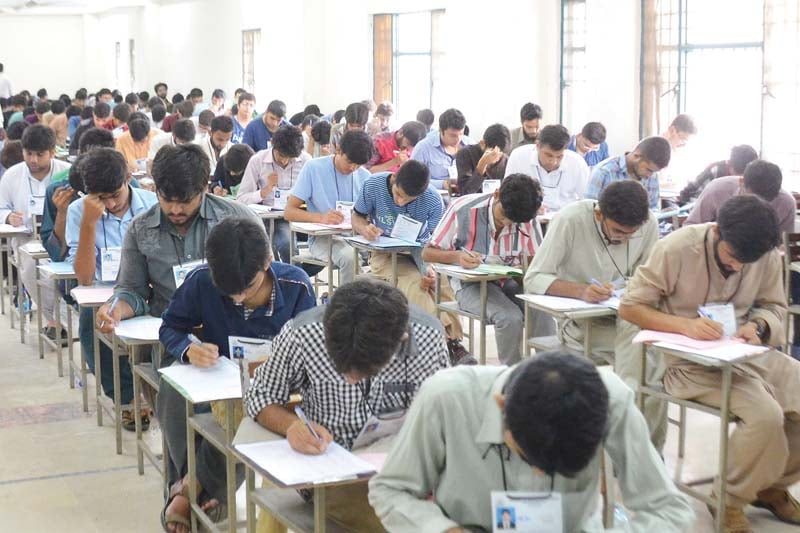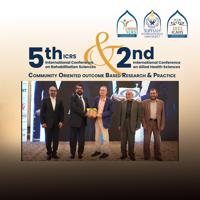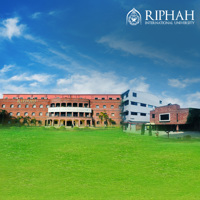
The BISE Lahore 11th Class Results 2025 are out, and the data reveals a familiar trend — female students once again outshined male students across almost every academic group. From Pre-Medical to Pre-Engineering, and even in Commerce and General Science, girls have shown stronger academic performance, reflecting their growing dominance in intermediate-level education.
This year’s Higher Secondary School Certificate (HSSC) Part-I results, released by the Board of Intermediate & Secondary Education (BISE) Lahore, highlight a significant gender gap in academic achievement. Despite a large number of boys appearing in the exams, girls maintained higher pass percentages and better overall performance ratios.
Overall Performance Overview
According to the official statistics released by BISE Lahore, a total of 167,397 students appeared in the 2025 HSSC First Annual Examination. Out of these, 108,984 students passed, making the overall pass percentage 65.09%.
Here’s how the performance breaks down by gender:
-
Boys: 80,099 appeared, 47,799 passed – 59.68% pass percentage
-
Girls: 87,298 appeared, 61,185 passed – 70.08% pass percentage
This clear difference of over 10% indicates that female students are outperforming male students at a consistent rate, showing better exam preparation, higher discipline, and more consistent academic focus.
Regular Candidates Performance by Group
Let’s explore how boys and girls performed across different academic streams:
1. Humanities Group
-
Male: 56,190 appeared, 23,512 passed – 41.84%
-
Female: 57,137 appeared, 22,152 passed – 38.78%
The Humanities group remains one of the largest in terms of enrollment. Interestingly, this is the only category where boys slightly outperformed girls. The gap, however, remains narrow. Male students achieved a pass rate of 41.84%, just above the 38.78% for females. This suggests that while both genders face challenges in this stream, male students managed a small lead this year.
2. Pre-Medical Group
-
Male: 20,649 appeared, 5,210 passed – 25.22%
-
Female: 21,213 appeared, 16,984 passed – 80.09%
The Pre-Medical group showcases the most striking difference in performance. Female students achieved an extraordinary 80.09% pass rate, compared to a mere 25.22% among male students. This enormous gap highlights not only the academic dedication of female students but also the strong competition among them for medical and healthcare-related careers.
Girls have historically dominated the pre-medical field, and the 2025 results reaffirm this ongoing trend.
3. Pre-Engineering Group
-
Male: 17,298 appeared, 6,338 passed – 36.65%
-
Female: 19,383 appeared, 13,646 passed – 70.40%
In Pre-Engineering, female candidates again outshone their male counterparts. With a 70.40% pass rate, girls nearly doubled the success rate of boys (36.65%). This result breaks the stereotype that engineering and technical subjects are male-dominated. It also reflects a growing number of female students showing interest and excellence in STEM fields (Science, Technology, Engineering, and Mathematics).
4. General Science Group
-
Male: 24,833 appeared, 14,708 passed – 59.26%
-
Female: 30,022 appeared, 19,636 passed – 65.43%
In the General Science group, the difference is smaller but still notable. Girls achieved a 65.43% pass rate, while boys managed 59.26%. This steady advantage for female candidates further supports the idea that female students demonstrate more consistent academic performance, even in less specialized streams.
5. Commerce Group
-
Male: 8,368 appeared, 5,590 passed – 66.82%
-
Female: 7,562 appeared, 5,489 passed – 72.60%
In the Commerce stream, both boys and girls performed relatively well, but girls maintained a 6% higher success rate. Their 72.60% pass percentage is among the highest across all groups, indicating a strong female presence in fields like accounting, finance, and business studies.
This also suggests that more female students are shifting toward commerce and business-related disciplines, which offer diverse career opportunities.
Gender Gap in Academic Performance
The gender gap in the BISE Lahore 11th Class Results 2025 clearly favors female students. With higher pass percentages in nearly every stream, female candidates have shown superior performance compared to their male peers.
The most significant gaps were observed in:
-
Pre-Medical (54.87% gap)
-
Pre-Engineering (33.75% gap)
-
Commerce (5.78% gap)
These statistics show that female students are excelling particularly in science and professional streams, breaking traditional barriers and proving that academic excellence is no longer gender-dependent.
Possible Reasons Behind Girls’ Better Performance
Several factors contribute to the consistent success of girls in board exams:
-
Higher Discipline and Consistency:
Female students often display better time management and academic consistency, leading to improved exam performance. -
Parental Encouragement:
Families increasingly support girls’ education, especially in urban areas like Lahore, resulting in stronger motivation and dedication. -
Focused Academic Environments:
Many girls’ colleges and institutions offer disciplined environments conducive to academic success. -
Career Aspirations:
Female students aiming for medical and professional careers often study harder to meet competitive admission criteria. -
Reduced Distractions:
Social factors, peer pressure, and lifestyle differences may also play a role in maintaining girls’ focus on studies.

Challenges for Male Students
While boys performed well in certain streams like Humanities and Commerce, their overall results suggest areas that need attention:
-
Lack of consistent study habits
-
Overconfidence leading to under-preparation
-
Less academic support in some institutions
-
Higher involvement in extracurricular or part-time activities
To bridge the gap, educators and policymakers must encourage male students to adopt better academic practices and focus more on examination preparation.
Expert Opinions
Education experts believe that this consistent trend of female academic dominance reflects positive changes in Pakistan’s education system. Girls are not only getting better access to education but are also proving their academic capabilities in challenging fields.
According to education analysts, these results also signal a cultural shift where girls are increasingly encouraged to pursue higher education and professional careers — especially in science and business.
Conclusion
The BISE Lahore 11th Class Results 2025 have once again highlighted that girls outperform boys across nearly every academic group. Whether in Pre-Medical, Pre-Engineering, General Science, or Commerce, female students demonstrated better results and higher pass percentages.
This growing academic excellence among girls is a positive sign for Pakistan’s educational future. It shows that with equal opportunities, girls can lead in academics, innovation, and professional success.
However, to achieve true educational balance, efforts must be made to motivate and guide male students so they can also perform to their full potential.
FAQs
1. Who performed better in BISE Lahore 11th Class Results 2025?
Female students performed significantly better than male students in almost all academic streams.
2. Which group had the highest pass percentage among girls?
The Pre-Medical group, with an impressive 80.09% pass rate.
3. Did boys outperform girls in any category?
Yes, only in the Humanities group, where boys had a slightly higher pass rate.
4. What is the overall pass percentage in BISE Lahore 11th Class 2025?
The overall pass rate was 65.09%, with 70.08% for girls and 59.68% for boys.
5. What does this mean for future education trends?
These results highlight the growing academic strength of female students and the need to support male students through improved academic guidance.














.jpeg)
